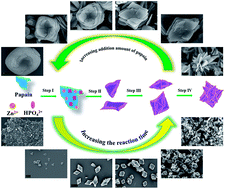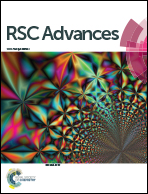Papain/Zn3(PO4)2 hybrid nanoflower: preparation, characterization and its enhanced catalytic activity as an immobilized enzyme†
Abstract
Flower-like papain/Zn3(PO4)2 hybrid materials are synthesized via a facile, rapid and low-cost method in this study. The growth process of the nanoflowers has been studied in detail and a four-step formation mechanism, including coordination, precipitation, self-assembly and size growth, has been clarified. The concentration of papain mainly affects the morphology of the products by regulating the assembly and crystal growth. The enzyme activity of papain/Zn3(PO4)2 hybrid nanoflowers, a novel immobilized enzyme, was calculated by monitoring the hydrolysis reaction of casein. The results show that the catalytic properties of papain immobilized on hybrid nanoflowers are enhanced compared with that of free papain. The as-prepared hybrid nanoflowers exhibited excellent reusability, high thermo stability and long storage life. The results indicate that the well-designed materials have great potential in industrial applications.


 Please wait while we load your content...
Please wait while we load your content...